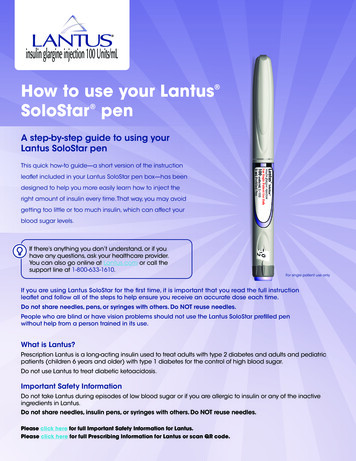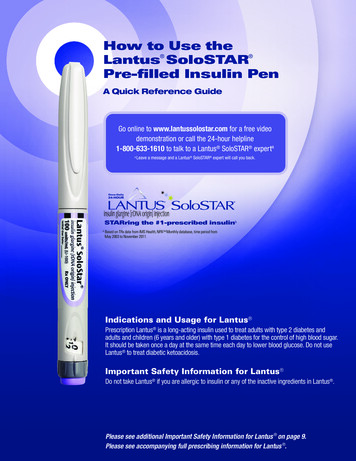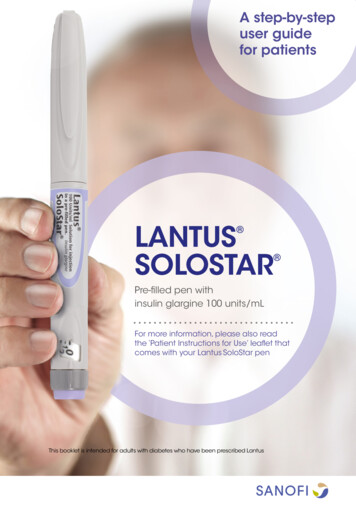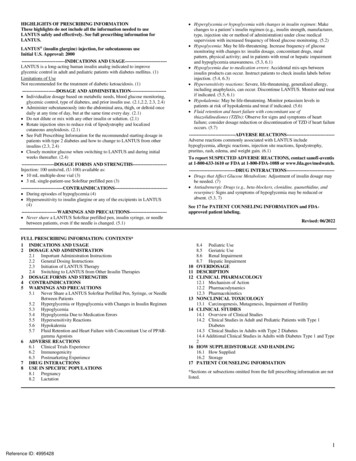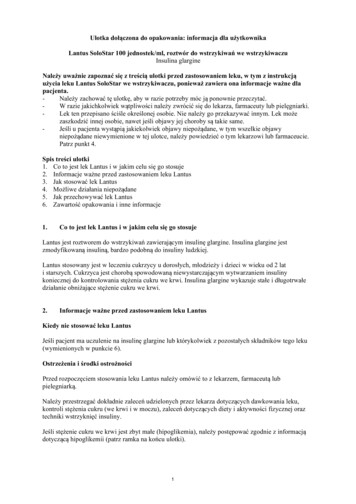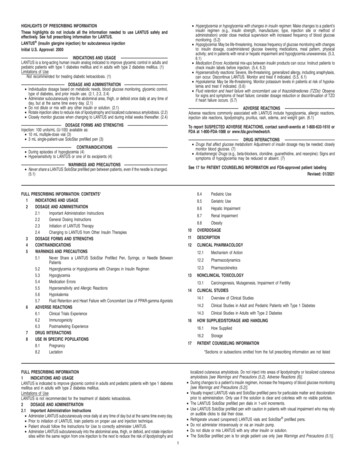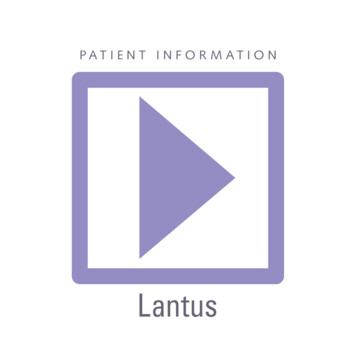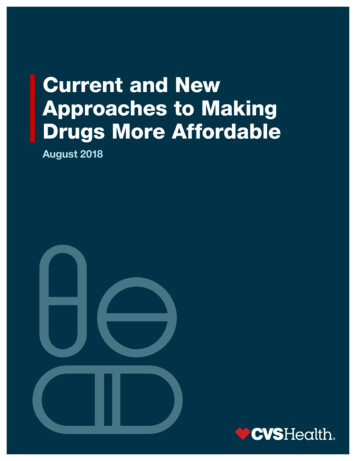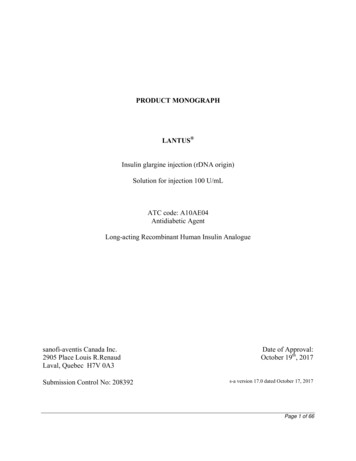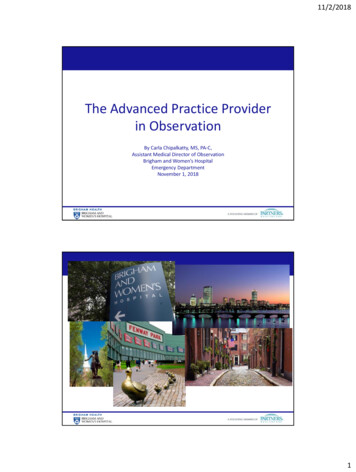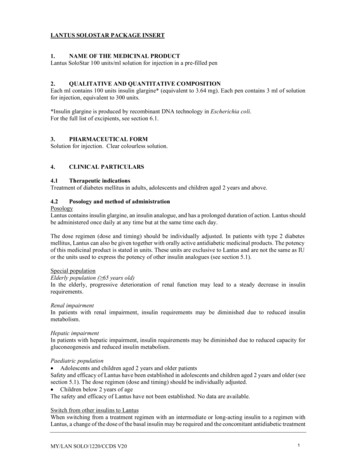
Transcription
LANTUS SOLOSTAR PACKAGE INSERT1.NAME OF THE MEDICINAL PRODUCTLantus SoloStar 100 units/ml solution for injection in a pre-filled pen2.QUALITATIVE AND QUANTITATIVE COMPOSITIONEach ml contains 100 units insulin glargine* (equivalent to 3.64 mg). Each pen contains 3 ml of solutionfor injection, equivalent to 300 units.*Insulin glargine is produced by recombinant DNA technology in Escherichia coli.For the full list of excipients, see section 6.1.3.PHARMACEUTICAL FORMSolution for injection. Clear colourless solution.4.CLINICAL PARTICULARS4.1Therapeutic indicationsTreatment of diabetes mellitus in adults, adolescents and children aged 2 years and above.4.2Posology and method of administrationPosologyLantus contains insulin glargine, an insulin analogue, and has a prolonged duration of action. Lantus shouldbe administered once daily at any time but at the same time each day.The dose regimen (dose and timing) should be individually adjusted. In patients with type 2 diabetesmellitus, Lantus can also be given together with orally active antidiabetic medicinal products. The potencyof this medicinal product is stated in units. These units are exclusive to Lantus and are not the same as IUor the units used to express the potency of other insulin analogues (see section 5.1).Special populationElderly population ( 65 years old)In the elderly, progressive deterioration of renal function may lead to a steady decrease in insulinrequirements.Renal impairmentIn patients with renal impairment, insulin requirements may be diminished due to reduced insulinmetabolism.Hepatic impairmentIn patients with hepatic impairment, insulin requirements may be diminished due to reduced capacity forgluconeogenesis and reduced insulin metabolism.Paediatric population Adolescents and children aged 2 years and older patientsSafety and efficacy of Lantus have been established in adolescents and children aged 2 years and older (seesection 5.1). The dose regimen (dose and timing) should be individually adjusted. Children below 2 years of ageThe safety and efficacy of Lantus have not been established. No data are available.Switch from other insulins to LantusWhen switching from a treatment regimen with an intermediate or long-acting insulin to a regimen withLantus, a change of the dose of the basal insulin may be required and the concomitant antidiabetic treatmentMY/LAN SOLO/1220/CCDS V201
may need to be adjusted (dose and timing of additional regular insulins or fast-acting insulin analogues orthe dose of oral antidiabetic medicinal products).Switch from twice daily NPH insulin to LantusTo reduce the risk of nocturnal and early morning hypoglycaemia, patients who are changing their basalinsulin regimen from a twice daily NPH insulin to a once daily regimen with Lantus should reduce theirdaily dose of basal insulin by 20-30% during the first weeks of treatment.Switch from insulin glargine 300 units/ml to LantusLantus and Toujeo (insulin glargine 300 units/ml) are not bioequivalent and are not directlyinterchangeable. To reduce the risk of hypoglycemia, patients who are changing their basal insulin regimenfrom an insulin regimen with once daily insulin glargine 300 units/ml to a once daily regimen with Lantusshould reduce their dose by approximately 20%.During the first weeks the reduction should, at least partially, be compensated by an increase in mealtimeinsulin, after this period the regimen should be adjusted individually.Close metabolic monitoring is recommended during the switch and in the initial weeks thereafter.With improved metabolic control and resulting increase in insulin sensitivity a further adjustment in doseregimen may become necessary. Dose adjustment may also be required, for example, if the patient's weightor life-style changes, change of timing of insulin dose or other circumstances arise that increasesusceptibility to hypo-or hyperglycaemia (see section 4.4).Patients with high insulin doses because of antibodies to human insulin may experience an improvedinsulin response with Lantus.Method of administrationLantus is administered subcutaneously.Lantus should not be administered intravenously. The prolonged duration of action of Lantus is dependenton its injection into subcutaneous tissue. Intravenous administration of the usual subcutaneous dose couldresult in severe hypoglycaemia.There are no clinically relevant differences in serum insulin or glucose levels after abdominal, deltoid orthigh administration of Lantus. Injection sites must be rotated within a given injection area from oneinjection to the next in order to reduce the risk of lipodystrophy and cutaneous amyloidosis (see section4.4 and 4.8).Lantus must not be mixed with any other insulin or diluted. Mixing or diluting can change its time/actionprofile and mixing can cause precipitation.Lantus SoloStar 100 units/ml in pre-filled pen is only suitable for subcutaneous injections. If administrationby syringe is necessary, a vial should be used (see section 4.4).Before using SoloStar, the instructions for use included in the package leaflet must be read carefully (seesection 6.6).4.3ContraindicationsHypersensitivity to the active substance or to any of the excipients listed in section 6.1.4.4Special warnings and precautions for useTraceabilityIn order to improve the traceability of biological medicinal products, the name and the batch number ofthe administered product should be clearly recorded.Lantus is not the insulin of choice for the treatment of diabetic ketoacidosis. Instead, regular insulinadministered intravenously is recommended in such cases.In case of insufficient glucose control or a tendency to hyper- or hypoglycaemic episodes, the patient'sMY/LAN SOLO/1220/CCDS V202
adherence to the prescribed treatment regimen, injection sites and proper injection technique and all otherrelevant factors must be reviewed before dose adjustment is considered.Transferring a patient to another type or brand of insulin should be done under strict medical supervision.Changes in strength, brand (manufacturer), type (regular, NPH, lente, long-acting, etc.), origin (animal,human, human insulin analogue) and/or method of manufacture may result in the need for a change in dose.Patients must be instructed to perform continuous rotation of the injection site to reduce the risk ofdeveloping lipodystrophy and cutaneous amyloidosis. There is a potential risk of delayed insulinabsorption and worsened glycaemic control following insulin injections at sites with these reactions. Asudden change in the injection site to an unaffected area has been reported to result in hypoglycaemia.Blood glucose monitoring is recommended after the change in the injection site, and dose adjustment ofantidiabetic medications may be considered.HypoglycaemiaThe time of occurrence of hypoglycaemia depends on the action profile of the insulins used and may,therefore, change when the treatment regimen is changed. Due to more sustained basal insulin supply withLantus, less nocturnal but more early morning hypoglycaemia can be expected.Particular caution should be exercised, and intensified blood glucose monitoring is advisable in patients inwhom hypoglycaemic episodes might be of particular clinical relevance, such as in patients with significantstenoses of the coronary arteries or of the blood vessels supplying the brain (risk of cardiac or cerebralcomplications of hypoglycaemia) as well as in patients with proliferative retinopathy, particularly if nottreated with photocoagulation (risk of transient amaurosis following hypoglycaemia).Patients should be aware of circumstances where warning symptoms of hypoglycaemia are diminished.The warning symptoms of hypoglycaemia may be changed, be less pronounced or be absent in certain riskgroups. These include patients:in whom glycaemic control is markedly improved,in whom hypoglycaemia develops gradually,who are elderly,after transfer from animal insulin to human insulin,in whom an autonomic neuropathy is present,with a long history of diabetes,suffering from a psychiatric illness,receiving concurrent treatment with certain other medicinal products (see section 4.5).Such situations may result in severe hypoglycaemia (and possibly loss of consciousness) prior to thepatient's awareness of hypoglycaemia.The prolonged effect of subcutaneous insulin glargine may delay recovery from hypoglycaemia.If normal or decreased values for glycated haemoglobin are noted, the possibility of recurrent, unrecognised(especially nocturnal) episodes of hypoglycaemia must be considered.Adherence of the patient to the dose and dietary regimen, correct insulin administration and awareness ofhypoglycaemia symptoms are essential to reduce the risk of hypoglycaemia. Factors increasing thesusceptibility to hypoglycaemia require particularly close monitoring and may necessitate dose adjustment.These include:change in the injection area,improved insulin sensitivity (e.g., by removal of stress factors),unaccustomed, increased or prolonged physical activity,intercurrent illness (e.g. vomiting, diarrhoea),inadequate food intake,missed meals,alcohol consumption,certain uncompensated endocrine disorders, (e.g. in hypothyroidism and in anterior pituitary orMY/LAN SOLO/1220/CCDS V203
-adrenocortical insufficiency),concomitant treatment with certain other medicinal products (see section 4.5).Intercurrent illnessIntercurrent illness requires intensified metabolic monitoring. In many cases urine tests for ketones areindicated, and often it is necessary to adjust the insulin dose. The insulin requirement is often increased.Patients with type 1 diabetes must continue to consume at least a small amount of carbohydrates on aregular basis, even if they are able to eat only little or no food, or are vomiting etc. and they must neveromit insulin entirely.Insulin antibodiesInsulin administration may cause insulin antibodies to form. In rare cases, the presence of such insulinantibodies may necessitate adjustment of the insulin dose in order to correct a tendency to hyper- orhypoglycaemia (see section 5.1).Handling of the SoloStar pre-filled penLantus SoloStar 100 units/ml in pre-filled pen is only suitable for subcutaneous injections. If administrationby syringe is necessary, a vial should be used (see section 4.2). Before using SoloStar, the instructions foruse included in the package leaflet must be read carefully. SoloStar has to be used as recommended in theseinstructions for use (see section 6.6).Medication errorsMedication errors have been reported in which other insulins, particularly short-acting insulins, have beenaccidentally administered instead of insulin glargine. Insulin label must always be checked before eachinjection to avoid medication errors between insulin glargine and other insulins.ExcipientsThis medicinal product contains less than 1 mmol (23 mg) sodium per dose, i.e. it is essentially ‘sodiumfree’.4.5Interaction with other medicinal products and other forms of interactionA number of substances affect glucose metabolism and may require dose adjustment of insulin glargine.Substances that may enhance the blood-glucose-lowering effect and increase susceptibility tohypoglycaemia include oral antidiabetic medicinal products, angiotensin converting enzyme (ACE)inhibitors, disopyramide, fibrates, fluoxetine, monoamine oxidase (MAO) inhibitors, pentoxifylline,propoxyphene, salicylates and sulfonamide antibiotics.Substances that may reduce the blood-glucose-lowering effect include corticosteroids, danazol, diazoxide,diuretics, glucagon, isoniazid, oestrogens and progestogens, phenothiazine derivatives, somatropin,sympathomimetic medicinal products (e.g. epinephrine [adrenaline], salbutamol, terbutaline), thyroidhormones, atypical antipsychotic medicinal products (e.g. clozapine and olanzapine) and proteaseinhibitors.Beta-blockers, clonidine, lithium salts or alcohol may either potentiate or weaken the blood-glucoselowering effect of insulin. Pentamidine may cause hypoglycaemia, which may sometimes be followed byhyperglycaemia.In addition, under the influence of sympatholytic medicinal products such as beta-blockers, clonidine,guanethidine and reserpine, the signs of adrenergic counter-regulation may be reduced or absent.4.6Fertility, pregnancy and lactationPregnancyFor insulin glargine no clinical data on exposed pregnancies from controlled clinical studies are available.A large amount of data on pregnant women (more than 1000 pregnancy outcomes) indicate no specificadverse effects of insulin glargine on pregnancy and no specific malformative nor feto/neonatal toxicity ofinsulin glargine.Animal data do not indicate reproductive toxicity.MY/LAN SOLO/1220/CCDS V204
The use of Lantus may be considered during pregnancy, if clinically needed.It is essential for patients with pre-existing or gestational diabetes to maintain good metabolic controlthroughout pregnancy to prevent adverse outcomes associated with hyperglycemia. Insulin requirementsmay decrease during the first trimester and generally increase during the second and third trimesters.Immediately after delivery, insulin requirements decline rapidly (increased risk of hypoglycaemia). Carefulmonitoring of glucose control is essential.Breast-feedingIt is unknown whether insulin glargine is excreted in human milk. No metabolic effects of ingested insulinglargine on the breast-fed newborn/infant are anticipated since insulin glargine as a peptide is digested intoaminoacids in the human gastrointestinal tract. Breast-feeding women may require adjustments in insulindose and diet.FertilityAnimal studies do not indicate direct harmful effects with respect to fertility.4.7Effects on ability to drive and use machinesThe patient's ability to concentrate and react may be impaired as a result of hypoglycaemia orhyperglycaemia or, for example, as a result of visual impairment. This may constitute a risk in situationswhere these abilities are of special importance (e.g. driving a car or using machines).Patients should be advised to take precautions to avoid hypoglycaemia whilst driving. This is particularlyimportant in those who have reduced or absent awareness of the warning symptoms of hypoglycaemia orhave frequent episodes of hypoglycaemia. It should be considered whether it is advisable to drive or usemachines in these circumstances.4.8Undesirable effectsSummary of the safety profileHypoglycaemia (very common), in general the most frequent adverse reaction of insulin therapy, mayoccur if the insulin dose is too high in relation to the insulin requirement (see section 4.4).Tabulated list of adverse reactionsThe following related adverse reactions from clinical investigations are listed below by system organ classand in order of decreasing incidence (very common: 1/10; common: 1/100 to 1/10; uncommon: 1/1,000 to 1/100; rare: 1/10,000 to 1/1,000; very rare: 1/10,000; not known: cannot be estimatedfrom the available data).Within each frequency grouping, adverse reactions are presented in order of decreasing seriousness.MedDRAsystem organclassesVery commonCommonUncommonImmune systemdisordersMetabolism and HypoglycaemianutritiondisordersMY/LAN SOLO/1220/CCDS V20Very rareNot knownAllergicreactionsNervous systemdisordersEyes disordersSkin andsubcutaneoustissue ipohypertrophyLipoatrophyCutaneousamyloidosis5
Musculoskeletal andconnectivetissue disordersGeneraldisorders andadministrationsite conditionsMyalgiaInjection sitereactionsOedemaDescription of selected adverse reactionsMetabolism and nutrition disordersSevere hypoglycaemic attacks, especially if recurrent, may lead to neurological damage. Prolonged orsevere hypoglycaemic episodes may be life-threatening.In many patients, the signs and symptoms of neuroglycopenia are preceded by signs of adrenergic counterregulation. Generally, the greater and more rapid the decline in blood glucose, the more marked is thephenomenon of counter-regulation and its symptoms (see section 4.4).Immune system disordersImmediate-type allergic reactions to insulin are rare. Such reactions to insulin (including insulin glargine)or the excipients may, for example, be associated with generalised skin reactions, angio-oedema,bronchospasm, hypotension and shock, and may be life-threatening.Eyes disordersA marked change in glycaemic control may cause temporary visual impairment, due to temporary alterationin the turgidity and refractive index of the lens.Long-term improved glycaemic control decreases the risk of progression of diabetic retinopathy. However,intensification of insulin therapy with abrupt improvement in glycaemic control may be associated withtemporary worsening of diabetic retinopathy. In patients with proliferative retinopathy, particularly if nottreated with photocoagulation, severe hypoglycaemic episodes may result in transient amaurosis.Skin and subcutaneous tissue disordersLipodystrophy and cutaneous amyloidosis may occur at the injection site and delay local insulin absorption.Continuous rotation of the injection site within the given injection area may help to reduce or prevent thesereactions (see section 4.4).General disorders and administration site conditionsInjection site reactions include redness, pain, itching, hives, swelling, or inflammation. Most minorreactions to insulins at the injection site usually resolve in a few days to a few weeks.Rarely, insulin may cause sodium retention and oedema particularly if previously poor metabolic controlis improved by intensified insulin therapy.Paediatric populationIn general, the safety profile for children and adolescents ( 18 years of age) is similar to the safety profilefor adults.The adverse reaction reports received from post marketing surveillance included relatively more frequentinjection site reactions (injection site pain, injection site reaction) and skin reactions (rash, urticaria) inchildren and adolescents ( 18 years of age) than in adults.Clinical study safety data are not available for children under 2 years.Reporting of suspected adverse reactionsReporting suspected adverse reactions after authorisation of the medicinal product is important. It allowscontinued monitoring of the benefit/risk balance of the medicinal product. Healthcare professionals areasked to report any suspected adverse reactions via the national reporting system.MY/LAN SOLO/1220/CCDS V206
4.9OverdoseSymptomsInsulin overdose may lead to severe and sometimes long-term and life-threatening hypoglycaemia.ManagementMild episodes of hypoglycaemia can usually be treated with oral carbohydrates. Adjustments in dose ofthe medicinal product, meal patterns, or physical activity may be needed.More severe episodes with coma, seizure, or neurologic impairment may be treated withintramuscular/subcutaneous glucagon or concentrated intravenous glucose. Sustained carbohydrate intakeand observation may be necessary because hypoglycaemia may recur after apparent clinical recovery.5.PHARMACOLOGICAL PROPERTIES5.1Pharmacodynamic propertiesPharmacotherapeutic group: Drugs used in diabetes, insulins and analogues for injection, long-acting. ATCCode: A10AE04.Mechanism of actionInsulin glargine is a human insulin analogue designed to have a low solubility at neutral pH. It is completelysoluble at the acidic pH of the Lantus injection solution (pH 4). After injection into the subcutaneous tissue,the acidic solution is neutralised leading to formation of micro-precipitates from which small amounts ofinsulin glargine are continuously released, providing a smooth, peakless, predictable concentration/timeprofile with a prolonged duration of action.Insulin glargine is metabolised into 2 active metabolites M1 and M2 (see section 5.2).Insulin receptor binding: In vitro studies indicate that the affinity of insulin glargine and its metabolitesM1 and M2 for the human insulin receptor is similar to the one of human insulin.IGF-1 receptor binding: The affinity of insulin glargine for the human IGF-1 receptor is approximately 5to 8-fold greater than that of human insulin (but approximately 70 to 80-fold lower than the one of IGF-1),whereas M1 and M2 bind the IGF-1 receptor with slightly lower affinity compared to human insulin.The total therapeutic insulin concentration (insulin glargine and its metabolites) found in type 1 diabeticpatients was markedly lower than what would be required for a halfmaximal occupation of the IGF-1receptor and the subsequent activation of the mitogenic-proliferative pathway initiated by the IGF-1receptor. Physiological concentrations of endogenous IGF-1 may activate the mitogenic-proliferativepathway; however, the therapeutic concentrations found in insulin therapy, including in Lantus therapy,are considerably lower than the pharmacological concentrations required to activate the IGF-1 pathway.The primary activity of insulin, including insulin glargine, is regulation of glucose metabolism. Insulin andits analogues lower blood glucose levels by stimulating peripheral glucose uptake, especially by skeletalmuscle and fat, and by inhibiting hepatic glucose production. Insulin inhibits lipolysis in the adipocyte,inhibits proteolysis and enhances protein synthesis.In clinical pharmacology studies, intravenous insulin glargine and human insulin have been shown to beequipotent when given at the same doses. As with all insulins, the time course of action of insulin glarginemay be affected by physical activity and other variables.In euglycaemic clamp studies in healthy subjects or in patients with type 1 diabetes, the onset of action ofsubcutaneous insulin glargine was slower than with human NPH insulin, its effect profile was smooth andpeakless, and the duration of its effect was prolonged.The following graph shows the results from a study in patients:MY/LAN SOLO/1220/CCDS V207
Activity Profile in Patients with Type 1 Diabetes*determined as amount of glucose infused to maintain constant plasma glucose levels (hourly mean values)The longer duration of action of subcutaneous insulin glargine is directly related to its slower rate ofabsorption and supports once daily administration. The time course of action of insulin and insulinanalogues such as insulin glargine may vary considerably in different individuals or within the sameindividual.In a clinical study, symptoms of hypoglycaemia or counter-regulatory hormone responses were similarafter intravenous insulin glargine and human insulin both in healthy volunteers and patients with type 1diabetes.In clinical studies, antibodies that cross-react with human insulin and insulin glargine were observed withthe same frequency in both NPH-insulin and insulin glargine treatment groups.Effects of insulin glargine (once daily) on diabetic retinopathy were evaluated in an open-label 5 year NPHcontrolled study (NPH given bid) in 1024 type 2 diabetic patients in which progression of retinopathy by3 or more steps on the Early Treatment Diabetic Retinopathy Study (ETDRS) scale was investigated byfundus photography. No significant difference was seen in the progression of diabetic retinopathy wheninsulin glargine was compared to NPH insulin.The ORIGIN (Outcome Reduction with Initial Glargine INtervention) study was a multicenter,randomised, 2x2 factorial design study conducted in 12,537 participants at high cardiovascular (CV) riskwith impaired fasting glucose (IFG) or impaired glucose tolerance (IGT) (12% of participants) or type 2diabetes mellitus treated with 1 antidiabetic oral agent (88% of participants). Participants wererandomised (1:1) to receive insulin glargine (n 6264), titrated to reach FPG 95 mg/dl (5.3 mM), orstandard care (n 6273).The first co-primary efficacy outcome was the time to the first occurrence of CV death, nonfatal myocardialinfarction (MI), or nonfatal stroke, and the second co-primary efficacy outcome was the time to the firstoccurrence of any of the first co-primary events, or revascularisation procedure (coronary, carotid, orperipheral), or hospitalisation for heart failure.Secondary endpoints included all-cause mortality and a composite microvascular outcome.Insulin glargine did not alter the relative risk for CV disease and CV mortality when compared to standardof care. There were no differences between insulin glargine and standard care for the two co-primaryoutcomes; for any component endpoint comprising these outcomes; for all-cause mortality; or for thecomposite microvascular outcome.MY/LAN SOLO/1220/CCDS V208
Mean dose of insulin glargine by study end was 0.42 U/kg. At baseline, participants had a median HbA1cvalue of 6.4% and median on-treatment HbA1c values ranged from 5.9 to 6.4% in the insulin glarginegroup, and 6.2% to 6.6% in the standard care group throughout the duration of follow-up.The rates of severe hypoglycaemia (affected participants per 100 participant years of exposure) were 1.05for insulin glargine and 0.30 for standard care group and the rates of confirmed non-severe hypoglycaemiawere 7.71 for insulin glargine and 2.44 for standard care group. Over the course of this 6-year study, 42%of the insulin glargine group did not experience any hypoglycaemia.At the last on-treatment visit, there was a mean increase in body weight from baseline of 1.4 kg in theinsulin glargine group and a mean decrease of 0.8 kg in the standard care group.Paediatric populationIn a randomised, controlled clinical study, paediatric patients (age range 6 to 15 years) with type 1 diabetes(n 349) were treated for 28 weeks with a basal-bolus insulin regimen where regular human insulin wasused before each meal. Insulin glargine was administered once daily at bedtime and NPH human insulinwas administered once or twice daily. Similar effects on glycohemoglobin and the incidence ofsymptomatic hypoglycemia were observed in both treatment groups, however fasting plasma glucosedecreased more from baseline in the insulin glargine group than in the NPH group.There was less severe hypoglycaemia in the insulin glargine group as well. One hundred forty three of thepatients treated with insulin glargine in this study continued treatment with insulin glargine in anuncontrolled extension study with mean duration of follow-up of 2 years. No new safety signals were seenduring this extended treatment with insulin glargine.A crossover study comparing insulin glargine plus lispro insulin to NPH plus regular human insulin (eachtreatment administered for 16 weeks in random order) in 26 adolescent type 1 diabetic patients aged 12 to18 years was also performed. As in the paediatric study described above, fasting plasma glucose reductionfrom baseline was greater in the insulin glargine group than in the NPH group. HbA1c changes frombaseline were similar between treatment groups; however blood glucose values recorded overnight weresignificantly higher in the insulin glargine/ lispro group than the NPH/regular group, with a mean nadir of5.4 mM versus 4.1 mM. Correspondingly, the incidences of nocturnal hypoglycaemia were 32% in theinsulin glargine / lispro group versus 52% in the NPH / regular group.A 24-week parallel group study was conducted in 125 children with type 1 diabetes mellitus aged 2 to 6years, comparing insulin glargine given once daily in the morning to NPH insulin given once or twice dailyas basal insulin. Both groups received bolus insulin before meals.The primary aim of demonstrating non-inferiority of insulin glargine to NPH in all hypoglycaemia was notmet and there was a trend to an increase of hypoglycemic events with insulin glargine [insulin glargine:NPH rate ratio (95% CI) 1.18 (0.97-1.44)].Glycohaemoglobin and glucose variabilities were comparable in both treatment groups. No new safetysignals were observed in this study.5.2Pharmacokinetic propertiesIn healthy subjects and diabetic patients, insulin serum concentrations indicated a slower and much moreprolonged absorption and showed a lack of a peak after subcutaneous injection of insulin glargine incomparison to human NPH insulin. Concentrations were thus consistent with the time profile of thepharmacodynamic activity of insulin glargine. The graph above shows the activity profiles over time ofinsulin glargine and NPH insulin.Insulin glargine injected once daily will reach steady state levels in 2-4 days after the first dose.When given intravenously the elimination half-life of insulin glargine and human insulin were comparable.After subcutaneous injection of Lantus in diabetic patients, insulin glargine is rapidly metabolized at thecarboxyl terminus of the Beta chain with formation of two active metabolites M1 (21A-Gly-insulin) andM2 (21A-Gly-des-30B-Thr-insulin). In plasma, the principal circulating compound is the metabolite M1.The exposure to M1 increases with the administered dose of Lantus. The pharmacokinetic andpharmacodynamic findings indicate that the effect of the subcutaneous injection with Lantus is principallyMY/LAN SOLO/1220/CCDS V209
based on exposure to M1. Insulin glargine and the metabolite M2 were not detectable in the vast majorityof subjects and, when they were detectable their concentration was independent of the administered doseof Lantus.In clinical studies, subgroup analyses based on age and gender did not indicate any difference in safety andefficacy in insulin glargine-treated patients compared to the entire study population.Paediatric populationPharmacokinetics in children aged 2 to less than 6 years with type 1 diabetes mellitus was assessed in oneclinical study (see section 5.1). Plasma “trough” levels of insulin glargine and its main M1 and M2metabolites were measured in children treated with insulin glargine, revealing plasma concentrationpatterns similar to adults, and providing no evidence for accumulation of insulin glargine or its metaboliteswith chronic dosing.5.3Preclinical safety dataNon-clinical data reveal no special hazard for humans based on conventional studies of safetypharmacolo
Lantus SoloStar 100 units/ml in pre-filled pen is only suitable for s ubcutaneous injections . If administration by syringe is necessary, a vial should be used (see section 4.4). Before using SoloStar, the instructions for use included in the package leaflet must be read carefully (see section 6.6). 4.3 Contraindications
